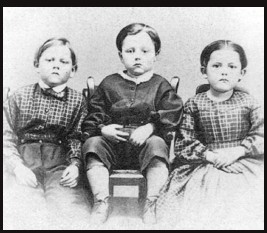 After the battle was over, the blanket of corpses and horror was almost too much to comprehend.
After the battle was over, the blanket of corpses and horror was almost too much to comprehend.
In one hollow, the body of a Union soldier was found. He had died alone, but must have known that he was going.
He had removed from his pocket a photograph of his three young children. His final sight must have been of them, as his unseeing eyes stared still at the picture.
After such tragedies, the human spirit wants to find something good to hold on to. This was one of the moments of humanity and pathos which quickly caught the public imagination after Gettysburg.
A press search was soon on, printing the photograph and calling upon the family to get in touch.
Someone did. This was Phelinda Humiston, a teacher and the mother of the three little ones. It was her husband who had died clutching the picture.
Readers reacted as they often do today, when confronted with something so sad. They sent money. So much money, in fact, that Mrs Humiston was suddenly quite rich. But she didn't spend it on a life of luxury. She set up an orphanage in Gettysburg itself, and took in only children orphaned by the battle.
So far so sad, but with a nice ending. That is until she grew too old to care for her wards. Over sixty children had passed through her care, but now she was exhausted.
Mrs Humiston entrusted her orphanage to an assistant named Rosa Carmichaels. What she wasn't to know is that Carmichaels was not the best woman for the job.
One day, a little girl fled from the house. She was half-starved and injured, which led credence to the story that she was about to relate. It seemed that child abuse was now rife in the house. Children were not only beaten by Carmichaels, but given sticks and encouraged to batter a little victim in mob violence.
In the basement were shackles. That's where Carmichaels chained up children whom she had selected to die. They were left there, disturbed only for torture with one of her many devices, until they expired from their wounds or starvation.
It is said, by local paranormal investigators and ghost tour operators, that the most haunted place of all is not on the open battlefield, but here, in the basement of the Soldiers' Orphanage, built in the wake of war.



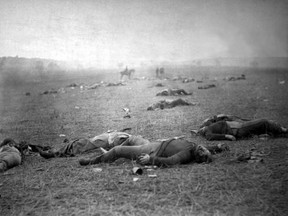 Anguished screams and the thunder of firearms have been clearly heard on the deserted plains. Fully formed phantom figures have appeared crouching in the grass or struggling with their backpacks, as they pass over the bridge.
Anguished screams and the thunder of firearms have been clearly heard on the deserted plains. Fully formed phantom figures have appeared crouching in the grass or struggling with their backpacks, as they pass over the bridge.

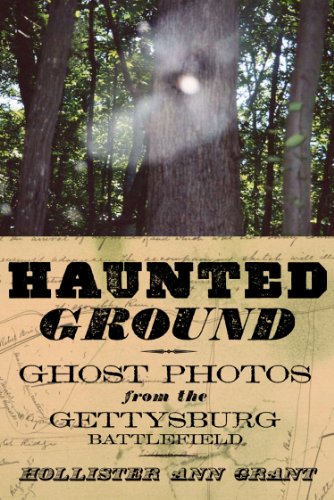
 Late one night, the McQuate family were driving down Highway 81, just north of Gettysburg. It was a lonely and completely deserted road. They hadn't passed any traffic for miles.
Late one night, the McQuate family were driving down Highway 81, just north of Gettysburg. It was a lonely and completely deserted road. They hadn't passed any traffic for miles.









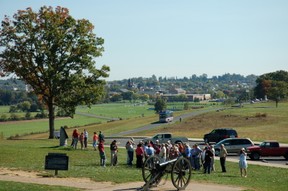 Mark Nesbitt lived and worked as a park ranger on the site, with his duties also taking in the National Cemetery and the Military Park.
Mark Nesbitt lived and worked as a park ranger on the site, with his duties also taking in the National Cemetery and the Military Park.


 After the battle was over, the blanket of corpses and horror was almost too much to comprehend.
After the battle was over, the blanket of corpses and horror was almost too much to comprehend.









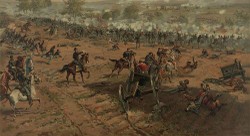

 St Tydecho's Churches in West Waleson 09/03/2014
St Tydecho's Churches in West Waleson 09/03/2014
 Goodies for an Outlander Premiere Partyon 03/06/2015
Goodies for an Outlander Premiere Partyon 03/06/2015
 Holocaust Memorial Day Interview with Rainer Höss, Grandson of Rudolf Architect of Auschwitzon 01/24/2015
Holocaust Memorial Day Interview with Rainer Höss, Grandson of Rudolf Architect of Auschwitzon 01/24/2015
 Romantic Valentine Gifts for an Outlander Fanon 01/16/2015
Romantic Valentine Gifts for an Outlander Fanon 01/16/2015

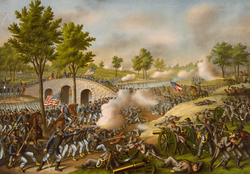

Have you had a ghostly encounter at Gettysburg? Please do tell!
I doubt anyone who's been there couldn't know.
I agree, and I know what Culloden felt like.
It certainly felt that way at Culloden.
I think that you are right Joe.
Frank - To my mind, it's the high emotion felt in such places which often cause the imprint to occur.
Rachel - I'll see if I can find any ghost stories pertaining to the American Revolution. There are bound to be some. I'm glad that my stories here engaged you so much!
This sort of phenomenon is known from other battlefields as well. Something lingers in these sites, as though places retain a record of events that happen in them. Yet it is not only the evil that men do that lives after them, the good is often retained in their stones [to play on Shakespeare.] Monastic ruins radiate peace,as do churches whose ancient stones have stones have seen centuries of worship.
Try to do one on the American Revolotion of how it first started the Shot heard around the world
Oh my gosh those stories are CREEPY the only reason i found this because my teacher told me to however now i like the story and i want to read more.
Please do report back if you do go. I'll have to look up the Richmond battlefields to see what's out there.